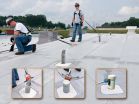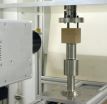(Press-News.org) (NEW YORK, NY, (August 4, 2011) – Columbia University Medical Center researchers have for the first time directly converted human skin cells into functional forebrain neurons, without the need for stem cells of any kind. The findings offer a new and potentially more direct way to produce replacement cell therapies for Alzheimer's and other neurodegenerative diseases. Such cells may prove especially useful for testing new therapeutic leads. The study was published in the August 4 online issue of the journal Cell.
In another first, the researchers used this method — called direct reprogramming — to generate neurons from skin cells of patients with familial (early-onset) Alzheimer's disease. The induced neurons were found to differ significantly from those made from healthy individuals, providing new insights into the development of the disease, reports study leader Asa Abeliovich, MD, PhD, associate professor of pathology & cell biology and neurology in the Taub Institute for Research on Alzheimer's Disease and the Aging Brain at Columbia University Medical Center (CUMC).
In the 1980s and 90s, scientists realized that embryonic stem cells, because of their pluripotency (ability to develop into any kind of cell) and capacity for self-renewal, might be useful in regenerating or replacing tissue after injury or disease. However, the use of cells from human embryos raised ethical issues, triggering a search for alternatives.
A breakthrough came in 2007, when researchers determined how to genetically reprogram human skin cells to become induced pluripotent stem (iPS) cells, which are similar to naturally pluripotent cells. Although this advance allowed researchers to avoid using embryonic stem cells, iPS technology remains complex, inefficient, and time-consuming. Moreover, the pluripotent stem cells by their nature are capable of forming tumors, leading to potential safety concerns.
In 2010, Stanford University researchers reported turning mouse skin cells directly into neurons using transcription regulators (proteins that switch genes on or off), bypassing the need to create iPS cells.
Building on that work, Dr. Abeliovich and his team used a different combination of transcription regulators, plus several neuronal support factors, to convert human skin cells into forebrain neurons. The induced neurons appear to be the same as ordinary neurons, judging from electrophysiological testing and gene expression profiling. The researchers also showed that the neurons are able to send and receive signals in laboratory culture and when transplanted into the central nervous system of mice. These findings indicate that the induced neurons are capable of neuronal activity.
"Direct reprogramming is fundamentally different from making neurons with iPS technologies," says Dr. Abeliovich. "Using direct reprogramming, you could, in theory, take someone's skin cells and in a couple of weeks have fully functional neurons ready for replacement cell therapy."
"Although the project is still at early stages and certainly not ready for clinical applications, therapies based on direct reprogramming seem more realistic than those based on iPS technology. "What is particularly exciting," says Dr. Abeliovich, "is that direct reprogramming is broadly applicable to the study and treatment of a host of neurological diseases."
In the second part of the study, Dr. Abeliovich compared neurons made from skin cells of healthy individuals with neurons made from patients with early-onset Alzheimer's disease. The latter cells exhibited altered processing and localization of amyloid precursor protein (APP) and increased concentration of amyloid beta, a component of APP (Alzheimer's is thought to develop when abnormal amounts of amyloid beta accumulate in the brain, eventually killing neurons.) APP was found to collect in the cells' endosomes, cellular compartments that sort molecules for degradation or recycling. These findings suggest that this form of Alzheimer's is caused, at least in part, by abnormal endosomal function, the researchers report.
###
Dr. Abeliovich's paper is entitled, "Directed Conversion Of Alzheimer's Disease Patient Skin Fibroblasts Into Functional Neurons." His coauthors are Liang Qiang, Ryousuke Fujita, Toru Yamashita, Herve Rhinn, David Rhee, Claudia Doege, Lily Chau, and William B. Vanti at CUMC and Sergio Angulo and Herman Moreno at the State University of New York Downstate Medical Center, Brooklyn, N.Y.
The New York State Stem Cell Science (NYSTEM), among others, provided funding for the study.
The authors declare no financial or other conflicts of interest.
The Taub Institute for Research on Alzheimer's Disease and the Aging Brain at Columbia University Medical Center is a multidisciplinary group that has forged links between researchers and clinicians to uncover the causes of Alzheimer's, Parkinson's and other age-related brain diseases and discover ways to prevent and cure these diseases. It has partnered with the Gertrude H. Sergievsky Center at Columbia University Medical Center which was established by an endowment in 1977 to focus on diseases of the nervous system. The Center integrates traditional epidemiology with genetic analysis and clinical investigation to explore all phases of diseases of the nervous system. For more information about these centers visit: http://www.cumc.columbia.edu/dept/taub/
http://www.cumc.columbia.edu/dept/sergievsky/
Columbia University Medical Center provides international leadership in basic, pre-clinical and clinical research, in medical and health sciences education, and in patient care. The medical center trains future leaders and includes the dedicated work of many physicians, scientists, public health professionals, dentists, and nurses at the College of Physicians and Surgeons, the Mailman School of Public Health, the College of Dental Medicine, the School of Nursing, the biomedical departments of the Graduate School of Arts and Sciences, and allied research centers and institutions. Established in 1767, Columbia's College of Physicians and Surgeons was the first institution in the country to grant the M.D. degree and is among the most selective medical schools in the country. Columbia University Medical Center is home to the largest medical research enterprise in New York City and State and one of the largest in the United States.
Human skin cells converted directly into functional neurons
Cells may prove useful for testing new therapeutic leads
2011-08-06
ELSE PRESS RELEASES FROM THIS DATE:
Caltech-led engineers solve longstanding problem in photonic chip technology
2011-08-06
PASADENA, Calif.—Stretching for thousands of miles beneath oceans, optical fibers now connect every continent except for Antarctica. With less data loss and higher bandwidth, optical-fiber technology allows information to zip around the world, bringing pictures, video, and other data from every corner of the globe to your computer in a split second. But although optical fibers are increasingly replacing copper wires, carrying information via photons instead of electrons, today's computer technology still relies on electronic chips.
Now, researchers led by engineers at ...
David Blair, QuadCap Wealth Management, and Bond Ladders I
2011-08-06
Bond Ladders, a powerful tool for retirement. A bond ladder works by spreading investment dollars among bonds that will mature at various times between one and fifteen years from now. In a normal interest rate environment, shorter maturities will yield less than longer maturities. Think of the individual bonds as rungs on your ladder. As each individual bond matures, your principal is made available for reinvestment at current interest rates.
The value of a ladder is the ability to reinvest the principal from the maturing bond into a new bond with a higher yield. The ...
Molecular mechanisms offer hope for new pain treatments
2011-08-06
This press release is available in French.
By working with individuals suffering from a severe disorder that causes sensory neurons to degenerate, researchers at the University of Montreal Hospital and CHU Sainte-Justine Hospital have discovered how a specific genetic mutation causes their patients' condition, which in turn has revealed more information about the mechanisms in our bodies which enable us to sense pain. Genetic mutations are mistakes in our genetic code that can either be passed from parents to their children or created when DNA is replicated. Lead author ...
New Miller ShockFusion Permanent Horizontal Lifeline Roof System Features Innovative Surface-Mounted Design
2011-08-06
Honeywell Safety Products announces the new Miller ShockFusion Permanent Horizontal Lifeline (HLL) Roof System - a versatile surface-mounted lifeline system that accommodates most industrial and commercial roof designs including standing seam, membrane, built-up, metal sheathing, concrete and wood.
- Attaches to the surface of existing roof structures - Quick, easy installation reduces costs by requiring minimal labor and eliminating the need for structural roof penetration and repair.
- Significantly reduces system forces on the roof - In the event of a fall, the ...
Better desalination technology key to solving world's water shortage
2011-08-06
New Haven, Conn.—Over one-third of the world's population already lives in areas struggling to keep up with the demand for fresh water. By 2025, that number will nearly double. Some countries have met the challenge by tapping into natural sources of fresh water, but as many examples – such as the much-depleted Jordan River – have demonstrated, many of these practices are far from sustainable.
A new Yale University study argues that seawater desalination should play an important role in helping combat worldwide fresh water shortages – once conservation, reuse and other ...
Researchers find way to help donor adult blood stem cells overcome transplant rejection
2011-08-06
DALLAS – Aug. 4, 2011 – Findings by UT Southwestern Medical Center researchers may suggest new strategies for successful donor adult stem cell transplants in patients with blood cancers such as leukemia, lymphoma and myeloma.
The study, published Aug. 5 in Cell Stem Cell, showed for the first time that adult blood stem cells can be regulated to overcome an immune response that leads to transplant rejection. It also opens up further studies in stem cell immunology, said Dr. Chengcheng "Alec" Zhang, assistant professor of physiology and developmental biology at UT Southwestern ...
Drinking just 1 measure of spirits increases the risk of acute pancreatitis
2011-08-06
Drinking just one 4cl measure of spirits can increase the risk of an acute attack of pancreatitis, but wine or beer does not appear to have the same effect, according to a study published online by BJS, the British Journal of Surgery.
Researchers from the Karolinska Institutet in Sweden followed 84,601 people from 46 to 84 years of age from the general population in Vastmanland and Uppsala for a median of ten years. During that time 513 developed acute pancreatitis.
"Our study revealed a steady increase between each measure of spirits a person drank on one occasion ...
Sexually extravagant male birds age more rapidly, but try to hide it
2011-08-06
For male houbara bustards sexual extravagance is the key to attracting mates in some of the world's harshest desert environments. However, new research in Ecology Letters reveals that males who perform the most extravagant sexual displays will suffer from premature biological aging and will pass their reproductive prime years earlier than their less ostentatious rivals.
Houbara bustards, Chlamydotis undulata, are found across the deserts of the Southern Hemisphere, from the Persian Gulf to the Gobi Desert, and for six months of the year the males spend their days in elaborate ...
Spotting weaknesses in solid wood
2011-08-06
This release is available in German.
People who buy an expensive solid wooden table or wardrobe want to be certain that their new piece of furniture is absolutely faultless. Pianos – whether upright or grand – can only produce an opulent tone if their soundboard, bridge and keyboard are made of high-quality materials. And wood that is free of imperfections is also essential in house building and window construction: load-bearing wooden beams need to be of the highest quality, as even the smallest crack can cause them to fail.
Research scientists from the Fraunhofer ...
Making runways safer
2011-08-06
This release is available in German.
It might have happened over ten years ago now, but most people can still recall the Concorde crash: the TV images showing the supersonic jet with flames streaming from its tail were unforgettable. It was a piece of metal lying on the runway during take-off that caused the accident. The aircraft's tire burst as it rolled over the metal, sending chunks of rubber flying into the fuel tank, which then exploded – with the loss of 113 lives. To avoid accidents such as this, airport staff drive up and down runways at six-hour intervals ...
LAST 30 PRESS RELEASES:
Chronic breathlessness emerging as a hidden strain on hospitals
Paleontologists find first fossil bee nests made inside fossil bones
These fossils were the perfect home for ancient baby bees
Not everyone reads the room the same. A new study examines why.
New research identifies linked energy, immune and vascular changes in ME/CFS
Concurrent frailty + depression likely boost dementia risk in older people
Living in substandard housing linked to kids’ missed schooling and poor grades
Little awareness of medical + psychological complexities of steroid cream withdrawal
Eight in 10 trusts caring for emergency department patients in corridors, finds BMJ investigation
NASA’s Webb telescope finds bizarre atmosphere on a lemon-shaped exoplanet
The gut bacteria that put the brakes on weight gain in mice
Exploring how patients feel about AI transcription
Category ‘6’ tropical cyclone hot spots are growing
Video: Drivers struggle to multitask when using dashboard touch screens, study finds
SLU research shows surge in alcohol-related liver disease driving ‘deaths of despair’
Rising heat reshapes how microbes break down microplastics, new review finds
Roots reveal a hidden carbon pathway in maize plants
Membrane magic: FAMU-FSU researchers repurpose fuel cells membranes for new applications
UN Member States pledge to increase access to diagnosis and inhaled medicines for the 480 million people living with COPD
Combination therapy shows potential to treat pediatric brain cancer ATRT
Study links seabird nesting to shark turf wars in Hawai‘i
Legal sports betting linked to sharp increases in violent crime, study finds
Breakthrough AI from NYUAD speeds up discovery of life-supporting microbes
New Eva Mayr-Stihl Foundation funding initiative boosts research at University of Freiburg on adaptation of forests to global change
The perfect plastic? Plant-based, fully saltwater degradable, zero microplastics
Bias in data may be blocking AI’s potential to combat antibiotic resistance
Article-level metrics would provide more recognition to most researchers than journal-level metrics
Satiety’s little helper: Protein that supports appetite regulating protein identified
UF dives deep into predicting storm damage with computer models
A stormy ocean voyage yields insights on the global carbon cycle
[Press-News.org] Human skin cells converted directly into functional neuronsCells may prove useful for testing new therapeutic leads




